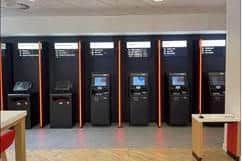Exclusive: New flagship HSBC UK branch opens in Doncaster following refurbishment
and live on Freeview channel 276
The branch has undergone significant investment and transformation during the nine-week refurbishment, and follows a commitment from HSBC UK to not announce any new branch closures in 2024.
The Doncaster branch has been completely renovated and has four new state of the art self-service machines which enable customers to deposit and withdraw cash and internally recycling the notes, new faster speed customer internet terminals, and a brand-new counter which is fully accessible for customers and staff.
Advertisement
Hide AdAdvertisement
Hide AdAll the self-service machines are now located together to make it easier for customers, alongside a wide variety of customer meeting areas, private rooms, booths, and a brand new ‘explore and discover’ meeting area for speedier interactions and customer education seminars.


Customers will find the new layout more user friendly with better accessibility and good visibility, new lighting, illuminated graphics, new flooring and a brand-new customer waiting area.
The Doncaster branch continues to offer a safe space for anyone in immediate need of a private and discreet space to reach out for specialist support.
The outside of the branch has also had a facelift, with a new illuminated HSBC UK hexagon’ sign, new signage, and will feature a brand-new external ATM, which dispenses £5 notes for improved access to cash, in addition to an internal ATM. The new external ATM, which will be installed shortly and sympathically to this listed building, will complete the refurbishment.
Advertisement
Hide AdAdvertisement
Hide AdJulie Ashcroft, HSBC UK’s Local Director has said: “We are extremely grateful to the local community and our customers for their patience and understanding during the refurbishment. I am proud that the Doncaster branch has been selected to receive this significant investment, turning it into a flagship branch, which is also a significant investment in the city of Doncaster.”


Julie added: “Customers will find accessibility better, especially those who use a wheelchair or mobility scooter and easier to navigate to the essential services they need, while benefitting from the new faster and more efficient machines and technology.
“Throughout the closure, our branch colleagues have been available at a ‘pop-up branch’ at the Frenchgate shopping centre helping people with a wide range of queries and account servicing. I would also like to thank them for the way they they adapted and continued to provide a great service at the ‘pop up’. The team are excited to welcome customers back into the branch, continuing to provide a fantastic service in much improved surroundings.”
Rt Hon Dame Rosie Winterton DBE, MP for Doncaster Central, visited the branch for a tour and said: “Great to get a sneak peak at the refurbished HSBC branch on our City Centre High Street. Julie Ashcroft, Local Director, and the fabulous team have done a superb job in looking after customers during the renovations with a pop up branch in the Frenchgate Centre. Really good to discuss with them all the improvements in services they can offer when the doors open on Monday.”
Advertisement
Hide AdAdvertisement
Hide AdHistory of HSBC UK serving the people of Doncaster since 1834


The HSBC UK Doncaster branch can trace the origins of its business back to 1834.
The Yorkshire District Banking Company was established in Leeds in 1834. In November of that year it opened a branch in Doncaster at No. 3 High Street. The firm was later reconstructed under the name of the Yorkshire Banking Company and in 1901 it was taken over by the London City and Midland Bank (now HSBC UK).
Meanwhile, in 1880, the premises of No. 1 High Street were taken up by the York City and County Banking Company. This bank had been established in 1830 and fifty years on it had developed a large network throughout the northern counties.
The branch at No.1 High Street Doncaster
Advertisement
Hide AdAdvertisement
Hide Ad

The business of the York City and County Bank branch at No 1. High Street had a slow start. The manager’s report at the end of the first year recorded that 63 accounts had been opened, but a profit of only £18 13s 8d had been made. Many of the branch’s customers were farmers and an agricultural depression around Doncaster restricted the bank’s business during those early years.
By the 1890s, however, the business of the branch had greatly improved. The town itself had grown and the bank was lending funds to local builders who were busy erecting homes for the growing population of Doncaster. The branch was now in need of much larger premises and the bank bought up the freehold of No. 2 High Street and Nos. 39-41 Baxtergate. These buildings were demolished to make way for an entirely new bank office. Architects De Maine and Brierley of York designed the premises and the building work was carried out by Messrs Anelay & Son of Doncaster. Construction began in 1896 and at its completion in 1898 the final bill amounted to £10,000.
The interior fittings were made of solid oak, mahogany and pitch-pine. Offices on the second floor were let to various companies and the third floor was taken up with the caretaker’s quarters. The Doncaster Review remarked:
“The structure is undoubtedly the largest and finest that has yet been erected in Doncaster for private business purposes, and the Company are to be commended for the enterprise they have shown, and the town gains an important street improvement . . .The style of the building is classic, and from the opposite corner of French-gate presents a very imposing appearance. Portland stone has been used, and some very fine chisel work may be observed. The interior fittings are of a solid and substantial character – oak, mahogany and pitch-pine being the wood chiefly used, and some splendid hand carving adds greatly to the beauty of the woodwork.”
Advertisement
Hide AdAdvertisement
Hide AdThat year, the manager of the branch, Mr W Smith, was able to report an annual profit of £1611 11s 3d and the number of accounts had increased to more than 500.
Amalgamation


In 1909 the York and County Bank amalgamated with the London Joint Stock Bank.
In 1914, at least three employees of the Doncaster branch of the London Joint Stock Bank enlisted with the armed forces and sadly lost their lives. They were Max William Pailthorpe, Harold Hoodless and Richard Pearce-Brown. A further eight employees from Midland Bank’s Doncaster branch (formerly of the Yorkshire Banking Company) enlisted to serve and all returned safely home.
The London Joint Stock Bank was taken over by Midland Bank in 1918. In 1923, Midland Bank took the decision to merge the two branches, when the business from No. 3 High Street was transferred next door into No. 1.
Advertisement
Hide AdAdvertisement
Hide AdWhen the Second World War broke out, 13 male members of staff enlisted with the armed forces and there were 27 female employees working at the branch. Eight of these women had been employed by the bank before the outbreak of war, three having been hired during the course of the First World War. 19 of the women were employed over the course of the war, to keep the branch’s work going with so many of the staff having left to enlist. One female employee of the Doncaster branch also left to join HM forces.
Banking was still heavily focused inside the branch in the 1950s, with the vast majority of transactions conducted onsite and with staff relying on manual typewriters, ledger-posting machines and hand-written reference cards. As the twentieth century progressed, life at the Doncaster branch gradually began to transform, especially as new technologies were introduced during the 1960s and the branch accounts were computerised on 11 December 1970.
Comment Guidelines
National World encourages reader discussion on our stories. User feedback, insights and back-and-forth exchanges add a rich layer of context to reporting. Please review our Community Guidelines before commenting.